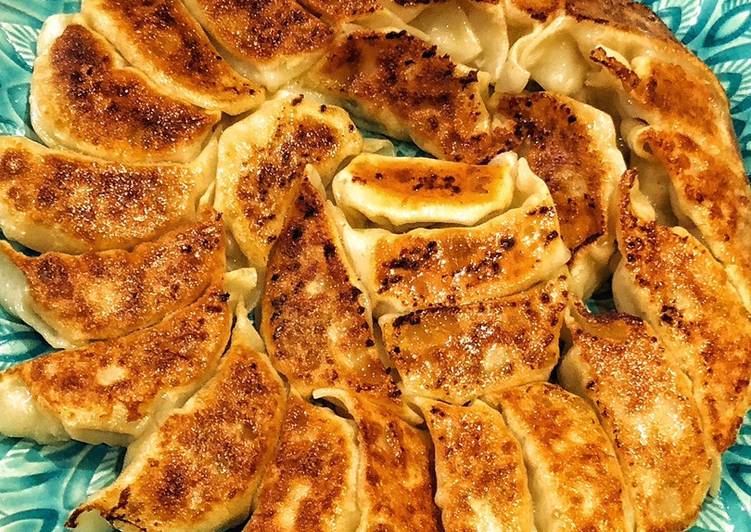Gyoza. Heat sesame oil in a large skillet over medium high heat. Mix in cabbage, onion, garlic and carrot. Cook and stir until cabbage is limp.
 Also known as pot stickers, gyoza originated in China (where they are called jiaozi), but have become a very popular dish in Japan.
Gyoza are very versatile—you can pan-fry, steam, boil or deep-fry them, or simply add a couple to your noodle soup.
These dumplings also freeze well in zip-lock bags.
You can cook Gyoza using 20 ingredients and 12 steps. Here is how you achieve it.
Also known as pot stickers, gyoza originated in China (where they are called jiaozi), but have become a very popular dish in Japan.
Gyoza are very versatile—you can pan-fry, steam, boil or deep-fry them, or simply add a couple to your noodle soup.
These dumplings also freeze well in zip-lock bags.
You can cook Gyoza using 20 ingredients and 12 steps. Here is how you achieve it.
Ingredients of Gyoza
- You need of For then Gyoza.
- Prepare of finely shredded Napa cabbage.
- You need of green onions, chopped.
- It's of coarse salt.
- You need of ground pork, preferably something on the fatty side like shoulder.
- It's of freshly ground black pepper.
- Prepare of piece of fresh ginger, peeled and grated.
- Prepare of garlic clove, minced.
- Prepare of soy sauce.
- Prepare of sake.
- You need of sesame oil.
- Prepare of gyoza wrappers (10-12 oz.).
- Prepare of vegetable oil.
- It's of For the Dipping Sauce:.
- Prepare of soy sauce.
- It's of seasoned rice vinegar (if unseasoned, add salt & sugar to taste).
- It's of sesame oil.
- Prepare of agave nectar.
- It's of Japanese chili pepper blend (Nanami Togarashi).
- Prepare of water to dilute.
Using a standard ice cream scoop or a ¼-cup measure, measure out balls of the udon gyoza mixture. Flatten each ball into a ½-inch thick patty in the palms of your hands, then place four to five. Gyoza (餃子), or Japanese pan-fried dumplings, are as ubiquitous as ramen in Japan. PS Traditionally, gyoza is served as part of a multi-course meal or as a side.
Gyoza instructions
- Toss the cabbage with the chopped green onions and the salt in a medium bowl. Let stand for 10 minutes or until cabbage is very wilted. Rinse and drain in a colander. Squeeze the cabbage and green onions, a handful at a time, to extract as much liquid as possible..
- Place the cabbage and green onions in a mixing bowl. Add the ground pork, pepper, ginger, garlic, soy sauce, sake, and sesame oil. Add a tiny pinch of salt, but not too much because the cabbage has already been salted. Mix everything together gently, but thoroughly..
- Fill a small bowl with water. Line a baking sheet with parchment paper and dust it with cornstarch..
- Place 1-2 teaspoons of the pork and cabbage filling into the center of a gyoza wrapper. Dip your finger into the water and moisten the edges of the wrapper. Bring one edge of the wrapper up over the filling to meet the other edge. Press the edges together firmly..
- Place the gyoza on the parchment pepper, plumping the bottom of the gyoza so that it stands with the pinched-together part facing up..
- Repeat with remaining filling and wrappers. Cover and refrigerate until ready to cook (can be made up to 4 hours ahead)..
- Preheat the oven to 200 degrees. Heat 2 TBS. of the oil in a nonstick skillet over medium-high heat until the oil is very hot but not sizzling..
- Place half the gyoza in the skillet, pinched part up, letting the gyoza touch each other (traditionally, they are served attached to each other, but it’s fine if they don’t!) Let cook for several minutes. Add 2/3 cup of water to the skillet and cover tightly. Cook for 5 minutes, adding more water if it evaporates before the 5 minutes is up..
- Cook until water is evaporated and the gyoza are nicely browned on the bottoms, about 7 minutes total. Invert the gyoza onto a platter and place in the oven to keep warm. Repeat with remaining 2 TBS. of oil and gyoza. Depending on the size of your skillet, you might need to do a third batch, adding a little extra oil..
- To make the dipping sauce, combine equal parts soy sauce and rice vinegar in a small bowl. Add a little splash of sesame oil, a sprinkle of Japanese chili pepper blend, and a little agave nectar for sweetness. Stir together..
- Add water to dilute the sauce slightly. Taste and adjust amount of water or ingredients until it tastes right to you. It should be a nice balance of salty, sweet, and sour, with a little spice..
- Serve the gyoza with a bowl of steamed rice and the dipping sauce on the side. Add a salad with sesame dressing and you have a comforting Japanese dinner!.
But in my family, we make an enormous batch, enough to have just gyoza as a meal. Gyoza are plump, Japanese dumplings typically filled with a mixture of ground pork, cabbage, chives, ginger and garlic. Jiaozi typically consist of a ground meat and/or vegetable filling wrapped into a thinly rolled piece of dough, which is then sealed by pressing the edges together. Finished jiaozi can be boiled (shuǐ jiǎo), steamed (zhēng jiǎo) or pan-fried (jiān jiǎo) and are traditionally served with a black vinegar and sesame oil dip. The Origin of Asian Dumplings Andrea Nguyen says the Chinese were the original inventors of Asian dumplings, called "jiaozi" in Mandarin.